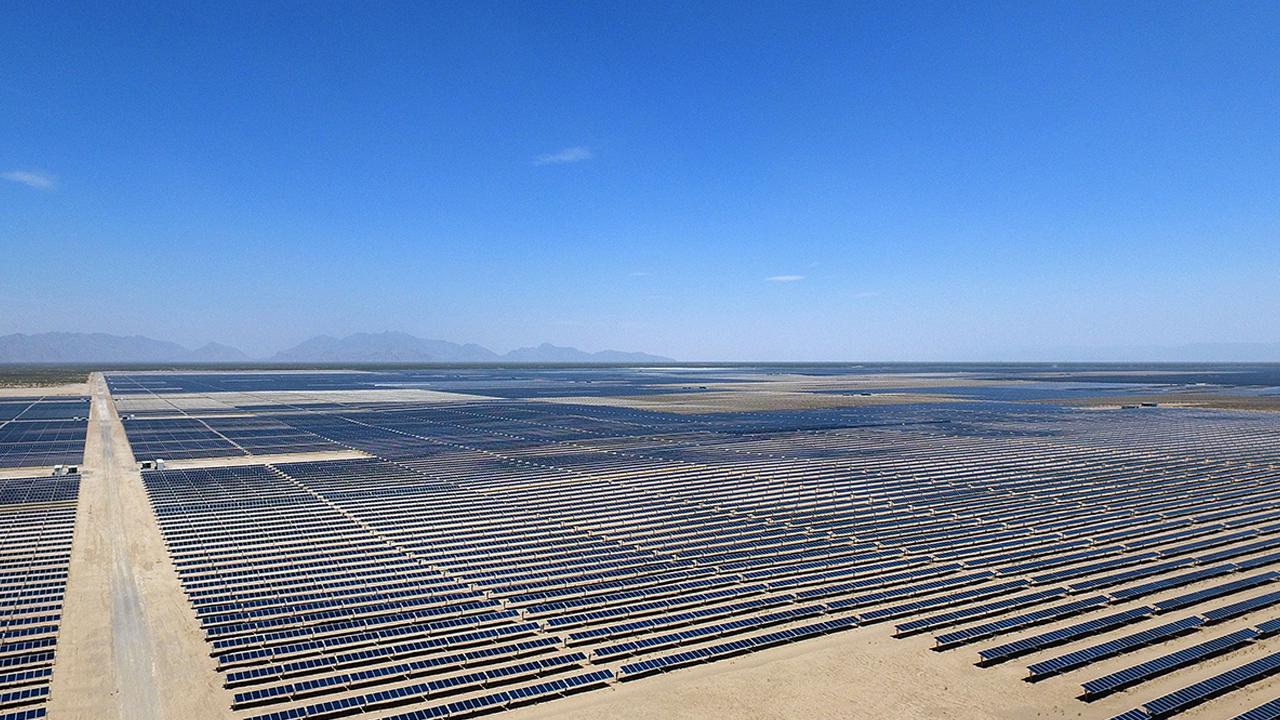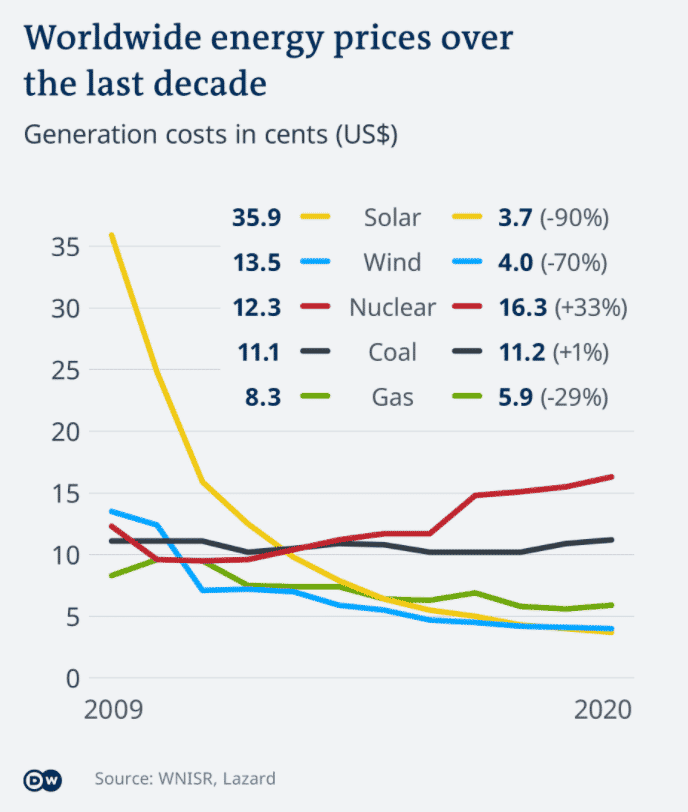

By Gero Rueter
Solar energy has become extremely cheap. In the desert of Saudi Arabia electricity from solar modules is now generated for just $0.01 (€0.009) per kilowatt hour (kWh), and in Portugal for $0.014 cents per kWh.
An increasing number of large solar parks are being built across the globe to help solve the planet’s energy needs.
Just how cheap is solar electricity?
Production costs for solar energy have dropped by 90% between 2009 and 2020, according to US investment bank Lazard.
In 2020, electricity from large-scale solar plants cost a global average of just $0.037/kWh. By comparison, the costs of generating electricity from new coal-powered plants was three times that at $0.112/kWh, while natural gas cost $0.059, nuclear $0.163, and wind $0.04/kWh.
“We’re going to see solar power plants all over the world. It’s the cheapest energy source in the world, with a few exceptions. In some places, wind power is still a bit cheaper,” said Christian Breyer, a professor of solar economy at LUT University in Finland.
With large solar farms, Breyer says, production costs can be as low as $0.01 in locations with lots of sunlight, and up to $0.04 elsewhere. He and other experts expect that new and more efficient solar panels will lower costs even more, by 5 to 10% per year.
How big are large solar farms?
The world’s largest solar parks have a capacity of 2,000 – 2,200 megawatts (MW), most are located in desert regions in China, India, and the Middle East, Egypt being a prime example. There are also big plants with over 500 MW in the US, Mexico, and southern Europe.
One of the largest solar parks, known as Al Dhafra PV2, is scheduled to begin supplying the United Arab Emirates’ national energy provider beginning next year. Under construction to the tune of $1 billion, the 2,000 MW plant will be comprised of four million modules installed over an area of 20 square kilometers near the capital, Abu Dhabi.
Most other solar parks around the world are smaller than the giant facilities in the desert. Germany’s largest solar park, for example, located in Weesow near Berlin, has an output of just 187 MW. Its 465,000 solar modules supply the electricity needs of about 50,000 households.
But even in densely populated countries like Germany, larger plants with a capacity of several thousand megawatts are conceivable. One place where they could be built are the quarries of abandoned open-cast lignite mines.
Where is solar power worthwhile for industry?
Globally, the industrial sector requires lots of energy. In Germany for instance it consumes about half of all electricity generated. To save costs, companies are turning to photovoltaics. International mining companies for instance have started replacing diesel power with solar power in remote locations. And more and more chemical companies, aluminum plants, car factories, cement manufacturers, and data centers are getting their power from solar farms.
One example is Facebook’s data center in the state of Tennessee, located in the southeastern US, which will get about 110 MW of electricity from a solar park with a capacity of 150 MW. The park is being built and operated by the German power company RWE.
Another example: starting in 2022, several Bayer Group’s chemical plants will run on 100% green electricity from a 590 MW-solar power plant in southern Spain.
The energy-intensive steel industry is also reorienting itself. Low-cost solar power is in demand there, as is “green” hydrogen generated by solar and wind power, which is needed for the blast furnace process. Low-cost energy supply is a decisive factor when planning the location of new steel mills.
Solar power is even proving to be worth the investment in regions with less exposure to the sun’s rays. One example is Poland’s largest solar park in Witnica, which has a capacity of 65 MW. It supplies the neighboring cement plant.
“This is the best proof that solar power, without any subsidies, can be competitive with power from conventional energy sources. Even in a European country as far north as Poland,” says Benedikt Ortmann from power plant operator BayWa r.e.
Where should we build solar power plants?
Experts estimate that in the near future, photovoltaic plants with a total capacity of around 60 million MW will be needed to supply the entire world with cost-effective electricity. That’s 70 times more than all the existing solar capacity so far.
The area required for solar panels would then be equivalent to 0.3% of the world’s land area.
“On a global average, you don’t have to worry about land availability,” said Christian Breyer of LTU Finland. But if the energy is to be generated as close as possible to cities and large factories, he says, it’s a bit more tricky, especially in densely populated regions.
One solution would be to use roofs and facades. According to Breyer, some 20% of the world’s solar power demand could be generated there.
So-called agrivoltaics, with solar roofs installed above fields, are also becoming increasingly important.
Another option: building solar panels that float on water. According to a World Bank study, the global potential of floating PV is 400,000 MW even if only one percent of the area of reservoirs is used for this purpose.
So far, the largest solar plants on inland lakes have been built in China, India, South Korea, and Taiwan. There are also smaller plants on lakes and reservoirs in many other countries, including the Netherlands, Israel and Indonesia. India is currently planning a large-scale floating plant with 1000 MW.
Meanwhile, research is underway in the Netherlands to find solutions for installing floating solar farms in the rough North Sea to povide energy for the national grid. But salt water, strong currents and winds still pose huge challenges.
Smaller floating facilities in offshore waters already exist, such as in the Maldives, where they provide electricity to vacation islands.
This article was adapted from German.
Reposted with permission from Deutsch Welle.

 233k
233k  41k
41k  Subscribe
Subscribe 
